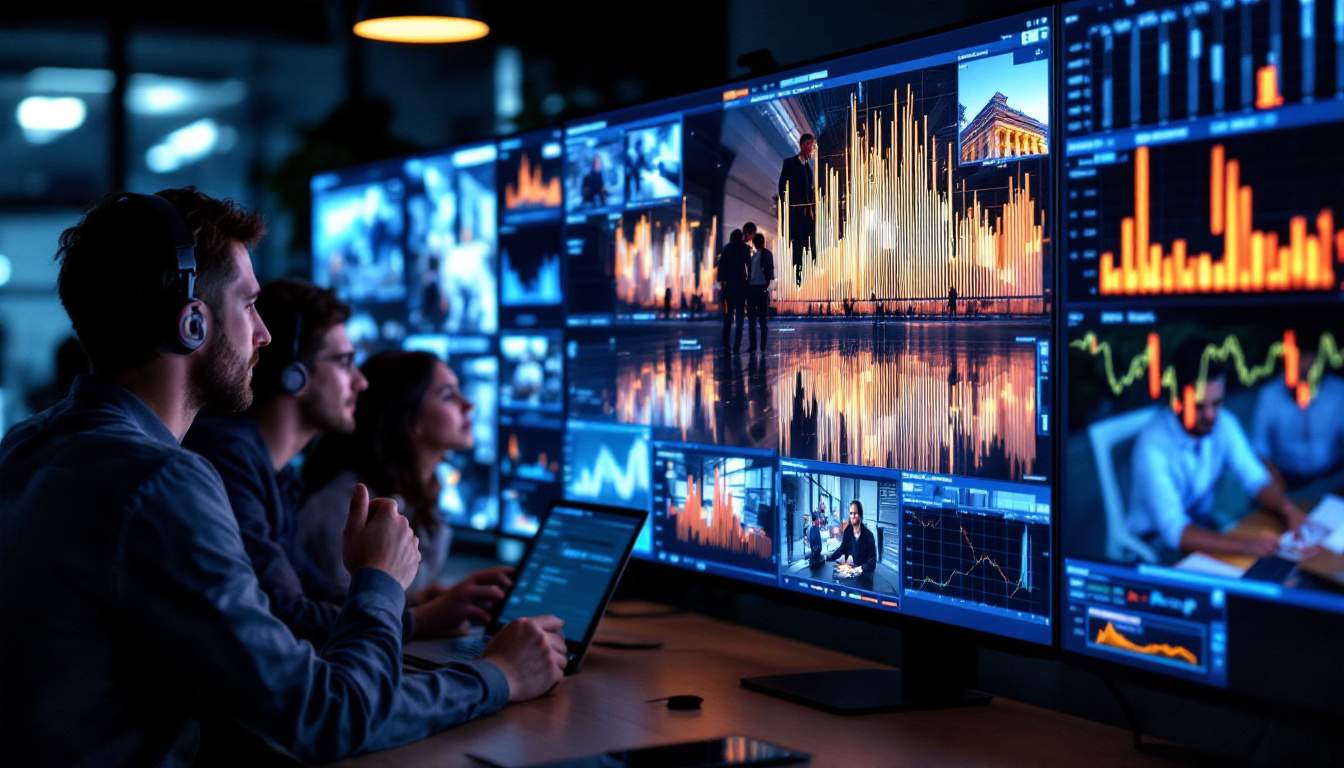Video Analytics: AI Video Analytics Explained
Video analytics, also known as video content analysis, is a technology that uses artificial intelligence (AI) to analyze video feeds and extract useful information. This technology has a wide range of applications, from security and surveillance to marketing and customer behavior analysis. AI video analytics is a rapidly evolving field, with new techniques and applications being developed all the time.
At its core, AI video analytics involves the use of machine learning algorithms to analyze video data. These algorithms are trained on large datasets of video footage, allowing them to learn patterns and identify objects, people, and events in new video feeds. This technology is becoming increasingly sophisticated, with the ability to recognize not just objects, but also actions, behaviors, and even emotions.
Components of AI Video Analytics
The AI video analytics process involves several key components, each of which plays a crucial role in the analysis of video data. These components include video capture, preprocessing, feature extraction, classification, and post-processing.
Video capture is the first step in the process, involving the collection of video data from cameras or other sources. Preprocessing involves the cleaning and formatting of this data, preparing it for analysis. Feature extraction involves the identification of key features in the video data, such as objects, people, or events. Classification involves the use of machine learning algorithms to categorize these features based on their characteristics. Finally, post-processing involves the interpretation of the results, turning raw data into actionable insights.
Video Capture
Video capture is the process of collecting video data from cameras or other sources. This can involve a wide range of technologies, from traditional CCTV cameras to more advanced systems such as drones or body-worn cameras. The quality of the video data collected during this stage can have a significant impact on the accuracy of the AI video analytics process.
There are many factors to consider when capturing video data, including the resolution of the camera, the frame rate, the lighting conditions, and the angle of view. Each of these factors can affect the quality of the video data and the ability of the AI system to accurately analyze it. For example, low-resolution video may not provide enough detail for the system to accurately identify objects or people, while poor lighting conditions can make it difficult for the system to distinguish between different colors or shapes.
Preprocessing
Preprocessing is the next stage in the AI video analytics process, involving the cleaning and formatting of the video data. This can involve a range of tasks, from removing noise and correcting color balance to resizing the video and converting it into a suitable format for analysis.
The goal of preprocessing is to improve the quality of the video data and make it easier for the AI system to analyze. This can involve a range of techniques, from simple image enhancement methods to more complex algorithms designed to correct for specific issues such as motion blur or lens distortion. The specific preprocessing techniques used can vary depending on the characteristics of the video data and the requirements of the AI system.
Feature Extraction
Feature extraction is a critical step in the AI video analytics process, involving the identification of key features in the video data. These features can include objects, people, events, or any other elements that are of interest. The goal of feature extraction is to reduce the amount of data that needs to be processed, focusing on the most important elements and ignoring irrelevant details.

There are many techniques for feature extraction, ranging from simple methods such as edge detection or color histogram analysis to more complex techniques such as deep learning. The choice of feature extraction technique can have a significant impact on the accuracy of the AI video analytics process, and is often a key area of research and development in the field.
Object Detection
Object detection is a key aspect of feature extraction, involving the identification of specific objects in the video data. This can include a wide range of objects, from people and vehicles to animals and items of interest. Object detection is often a critical step in the AI video analytics process, as it allows the system to focus on specific elements of the video and ignore irrelevant details.
There are many techniques for object detection, ranging from simple methods such as background subtraction or template matching to more advanced techniques such as deep learning. The choice of object detection technique can depend on a range of factors, including the complexity of the video data, the types of objects that need to be detected, and the requirements of the AI system.
Event Detection
Event detection is another important aspect of feature extraction, involving the identification of specific events or actions in the video data. This can include a wide range of events, from a person entering a restricted area to a vehicle exceeding the speed limit. Event detection can provide valuable insights into the behavior of people or objects in the video, and is often a key focus of AI video analytics.
There are many techniques for event detection, ranging from simple methods such as thresholding or rule-based systems to more advanced techniques such as machine learning or deep learning. The choice of event detection technique can depend on a range of factors, including the complexity of the video data, the types of events that need to be detected, and the requirements of the AI system.
Classification
Classification is the process of categorizing the features identified during the feature extraction stage based on their characteristics. This can involve a range of tasks, from identifying the type of object or person to determining the nature of an event or action. Classification is a critical step in the AI video analytics process, as it allows the system to make sense of the data and generate actionable insights.
There are many techniques for classification, ranging from simple methods such as decision trees or k-nearest neighbors to more advanced techniques such as support vector machines or deep learning. The choice of classification technique can depend on a range of factors, including the complexity of the data, the number of categories, and the requirements of the AI system.
Object Classification
Object classification involves the categorization of objects based on their characteristics. This can involve a range of tasks, from identifying the type of object (e.g., person, vehicle, animal) to determining specific attributes of the object (e.g., color, size, shape). Object classification can provide valuable insights into the nature of the objects in the video, and is often a key focus of AI video analytics.
There are many techniques for object classification, ranging from simple methods such as decision trees or k-nearest neighbors to more advanced techniques such as support vector machines or deep learning. The choice of object classification technique can depend on a range of factors, including the complexity of the data, the number of categories, and the requirements of the AI system.
Event Classification
Event classification involves the categorization of events or actions based on their characteristics. This can involve a range of tasks, from identifying the type of event (e.g., intrusion, theft, accident) to determining specific attributes of the event (e.g., location, time, severity). Event classification can provide valuable insights into the nature of the events in the video, and is often a key focus of AI video analytics.
There are many techniques for event classification, ranging from simple methods such as decision trees or k-nearest neighbors to more advanced techniques such as support vector machines or deep learning. The choice of event classification technique can depend on a range of factors, including the complexity of the data, the number of categories, and the requirements of the AI system.
Post-Processing
Post-processing is the final stage in the AI video analytics process, involving the interpretation of the results and the generation of actionable insights. This can involve a range of tasks, from visualizing the results to generating reports or alerts. Post-processing is a critical step in the AI video analytics process, as it allows the system to communicate its findings and provide value to the user.

There are many techniques for post-processing, ranging from simple methods such as data visualization or report generation to more advanced techniques such as anomaly detection or predictive analytics. The choice of post-processing technique can depend on a range of factors, including the complexity of the data, the requirements of the user, and the capabilities of the AI system.
Data Visualization
Data visualization involves the presentation of the results in a visual format, making it easier for the user to understand and interpret the data. This can involve a range of techniques, from simple graphs or charts to more complex visualizations such as heat maps or 3D models. Data visualization can provide a powerful way to communicate the findings of the AI video analytics process, and is often a key focus of post-processing.
There are many techniques for data visualization, ranging from simple methods such as bar charts or line graphs to more advanced techniques such as scatter plots or heat maps. The choice of data visualization technique can depend on a range of factors, including the complexity of the data, the requirements of the user, and the capabilities of the AI system.
Report Generation
Report generation involves the creation of detailed reports based on the results of the AI video analytics process. These reports can provide a comprehensive overview of the findings, including detailed information on the objects, events, and actions identified in the video. Report generation can provide a valuable tool for users, allowing them to easily review and understand the results of the AI video analytics process.
There are many techniques for report generation, ranging from simple methods such as text reports or spreadsheets to more advanced techniques such as interactive dashboards or automated email reports. The choice of report generation technique can depend on a range of factors, including the complexity of the data, the requirements of the user, and the capabilities of the AI system.
Applications of AI Video Analytics
AI video analytics has a wide range of applications, from security and surveillance to marketing and customer behavior analysis. The technology can be used to monitor and analyze video feeds in real-time, providing valuable insights and alerts that can help to improve security, efficiency, and decision-making.
Some of the key applications of AI video analytics include intrusion detection, crowd monitoring, traffic analysis, and customer behavior analysis. Each of these applications involves the use of AI video analytics to analyze video feeds and extract useful information, providing valuable insights that can be used to improve operations and decision-making.
Intrusion Detection
Intrusion detection involves the use of AI video analytics to monitor video feeds and detect unauthorized access or activity. This can involve a range of tasks, from identifying intruders to detecting suspicious behavior. Intrusion detection can provide a powerful tool for security and surveillance, helping to prevent theft, vandalism, and other forms of unauthorized activity.
There are many techniques for intrusion detection, ranging from simple methods such as motion detection or perimeter monitoring to more advanced techniques such as behavioral analysis or anomaly detection. The choice of intrusion detection technique can depend on a range of factors, including the complexity of the video feed, the nature of the threat, and the requirements of the security system.
Crowd Monitoring
Crowd monitoring involves the use of AI video analytics to monitor large groups of people and analyze their behavior. This can involve a range of tasks, from counting the number of people in a crowd to detecting unusual behavior or identifying potential threats. Crowd monitoring can provide a valuable tool for event management, public safety, and other applications where the behavior of large groups of people needs to be monitored.
There are many techniques for crowd monitoring, ranging from simple methods such as people counting or density estimation to more advanced techniques such as behavioral analysis or anomaly detection. The choice of crowd monitoring technique can depend on a range of factors, including the complexity of the video feed, the nature of the crowd, and the requirements of the monitoring system.
Challenges and Future Directions
While AI video analytics is a powerful technology with a wide range of applications, it also faces a number of challenges. These include issues related to data quality, privacy and ethics, and the complexity of video data. Despite these challenges, the field of AI video analytics is rapidly evolving, with new techniques and applications being developed all the time.

Some of the key challenges in AI video analytics include the need for high-quality video data, the complexity of video analysis, and the ethical and privacy issues associated with the use of AI. Each of these challenges presents significant obstacles, but also opportunities for innovation and improvement. As the field continues to evolve, it is likely that these challenges will be addressed through the development of new techniques and technologies.
Data Quality
The quality of the video data is a critical factor in the success of AI video analytics. Poor quality video can make it difficult for the AI system to accurately identify objects, people, or events, leading to inaccurate results. Factors such as low resolution, poor lighting conditions, and motion blur can all affect the quality of the video data and the accuracy of the AI video analytics process.
Improving the quality of the video data is a key challenge in AI video analytics. This can involve a range of strategies, from improving the quality of the video capture equipment to developing more sophisticated preprocessing techniques. As the field continues to evolve, it is likely that new techniques and technologies will be developed to address this challenge.
Privacy and Ethics
The use of AI video analytics raises a number of ethical and privacy issues. These include concerns about surveillance and the potential misuse of the technology, as well as issues related to data protection and consent. Addressing these issues is a key challenge in the field of AI video analytics, and requires a careful balance between the benefits of the technology and the need to protect individual privacy and rights.
There are many strategies for addressing the ethical and privacy issues associated with AI video analytics, ranging from legal and regulatory measures to the development of privacy-preserving technologies. As the field continues to evolve, it is likely that these issues will continue to be a key focus of research and development.
Complexity of Video Data
Video data is inherently complex, with a high degree of variability and a large amount of information to process. This complexity presents a significant challenge for AI video analytics, requiring sophisticated algorithms and high-performance computing resources. Despite these challenges, the complexity of video data also presents opportunities for innovation and improvement, with the potential to develop new techniques and applications that can extract valuable insights from this rich source of data.
Addressing the complexity of video data is a key challenge in AI video analytics. This can involve a range of strategies, from developing more efficient algorithms to leveraging advances in computing technology. As the field continues to evolve, it is likely that new techniques and technologies will be developed to address this challenge.


